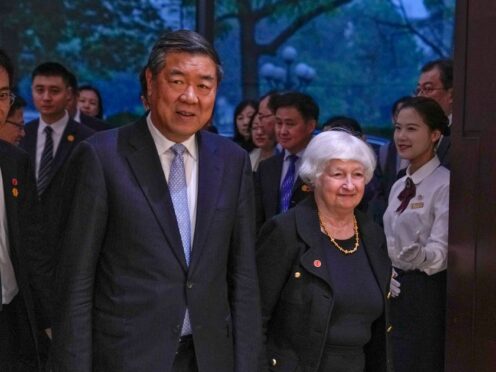
The US and China have agreed to hold talks that will address a key American complaint about China’s economic model, US treasury secretary Janet Yellen said on the second day of an official visit to China.
The two sides will hold “intensive exchanges” on more balanced economic growth, according to a US statement issued after Ms Yellen and Chinese vice premier He Lifeng held extended meetings over two days in the southern city of Guangzhou.
They also agreed to start exchanges on combating money laundering, the US statement said.
Ms Yellen, who headed to Beijing after starting her five-day visit in one of China’s major industrial and export hubs, said the exchange on balanced growth would create a structure to hear each other’s views and try to address American concerns about manufacturing overcapacity in China.
“I think the Chinese realise how concerned we are about the implications of their industrial strategy for the United States, for the potential to flood our markets with exports that make it difficult for American firms to compete,” Ms Yellen told reporters after the announcement.
“It’s not going to be solved in an afternoon or a month, but I think they have heard that this is an important issue to us.”
China’s official Xinhua News Agency said that the two sides had agreed to discuss a range of issues including balanced growth of the United States, China and the global economy as well as financial stability, sustainable finance and co-operation in countering money-laundering.
It added in an initial dispatch that China had responded fully on the issue of production capacity, but did not provide details.

China also expressed grave concern over American trade and economic measures that restrict China, Xinhua said.
Chinese government subsidies and other policy support have encouraged solar panel and EV makers in China to invest in factories, building far more production capacity than the domestic market can absorb.
The massive scale of production has driven down costs and ignited price wars for green technologies, a boon for consumers and efforts to reduce global dependence on fossil fuels.
But Western governments fear that that capacity will flood their markets with low-priced exports, threatening American and European jobs.
“It’s going to be critical to our bilateral relationship going forward and to China’s relationship with other countries that are important, and this provides a structured way in which we can continue to listen to one another and see if we can find a way forward that will avoid conflict,” Ms Yellen told reporters.
The exchanges on balanced growth and money laundering will be held under the framework of existing economic and financial working groups that were set up after Ms Yellen met Mr He in July.
Ms Yellen struck a positive note on joint efforts to address US concerns about Chinese companies selling goods to Russia following its invasion of Ukraine.
“We think there’s more to do, but I do see it as an area where we’ve agreed to co-operate and we’ve already seen some meaningful progress,” she said.
Earlier state media coverage of her trip had characterised US concerns about overcapacity as a possible pretext for tariffs.
In a commentary published on Friday night, Xinhua wrote that while Ms Yellen’s trip is a good sign that the world’s two largest economies are maintaining communication, “talking up ‘Chinese overcapacity’ in the clean energy sector also smacks of creating a pretext for rolling out more protectionist policies to shield US companies”.
Ms Yellen told reporters during an Alaska refuelling stop en route to China that the US “won’t rule out” tariffs to respond to China’s heavily subsidised manufacturing of green energy products.
The US has made efforts through legislation and executive orders to wean itself off certain Chinese technologies in order to build out its domestic manufacturing capabilities.
Many members of the White House and Congress view the actions as important to maintaining national security.
The 280 billion dollar CHIPS and Science Act passed in 2022 aims to boost the semiconductor industry and scientific research in a bid to create more high-tech jobs in the United States and help it better compete with China.
Additionally, last August US President Joe Biden signed an executive order to block and regulate high-tech US-based investments going towards China.
Ms Yellen will hold meetings in Beijing with more senior officials and economists on Sunday and Monday.

Enjoy the convenience of having The Sunday Post delivered as a digital ePaper straight to your smartphone, tablet or computer.
Subscribe for only £5.49 a month and enjoy all the benefits of the printed paper as a digital replica.
Subscribe